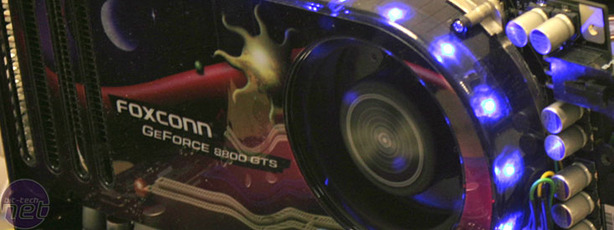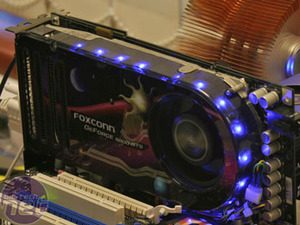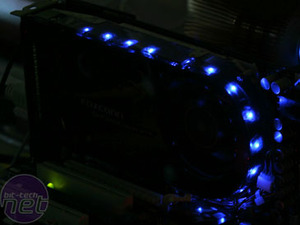The eagle eyed amongst you will notice some extra wires next to the fan connector on the card. Foxconn has installed an array of blue LEDs and used the power connector for the fan to power them. This is a small step away from the reference design and does help to add a little more differentiation into Foxconn's card. Many of you will love the bright blue glow emitted from the card but essentially, it's a novelty - the LEDs aren't going to make you a better gamer. They might get a few more people curiously looking at what's inside your case at a LAN, though.
Personally, I don’t like the idea of lots of blue shining through the window on my case all of the time, but I probably wouldn't mind them so much if there was the option to turn the lighting off. Also, there is a bit of a mess of hot glue and wires around the fan power connector on the card we have here, but Foxconn has assured us that the card wiring won’t look like that on a final retail version of the card. Hopefully, Foxconn has come up with a more elegant way to implement its flashy LED design on the card.
NVIDIA recommended that the minimum resolution we should test GeForce 8800 at should be no lower than 1600x1200. However, in order to really see the benefits of GeForce 8800-series, you're going to need a 24" or 30" widescreen monitor.
Because the benchmarks are done manually, there are slight differences between runs. However, we have run each benchmarking scenario through at least three times to get consistent average and minimum frame rates. In order to understand our testing methodologies, you will not go far wrong by following the logic that the higher the anti-aliasing, anisotropic filtering and in game details, the faster the graphics solution in that particular title.

We use the following abbreviations on our best-playable settings tables:
Personally, I don’t like the idea of lots of blue shining through the window on my case all of the time, but I probably wouldn't mind them so much if there was the option to turn the lighting off. Also, there is a bit of a mess of hot glue and wires around the fan power connector on the card we have here, but Foxconn has assured us that the card wiring won’t look like that on a final retail version of the card. Hopefully, Foxconn has come up with a more elegant way to implement its flashy LED design on the card.
Warranty:
All of Foxconn's video cards come with a two-year parts and labour warranty - this is the minimum warranty term for goods of this type in the EU. In the first year after purchase, you should contact the retailer if you're having problems with the card. After the first year of ownership has finished, you should then contact Foxconn directly. In all honesty, it's a little no frills on the warranty front and it's definitely not a match to what the guys at BFGTech offer.Gameplay Evaluations – How We Tested:
There are no timedemos used in our evaluations – we're focusing on the real-world gameplay experience. Ultimately, this is what should determine your next video card purchase.NVIDIA recommended that the minimum resolution we should test GeForce 8800 at should be no lower than 1600x1200. However, in order to really see the benefits of GeForce 8800-series, you're going to need a 24" or 30" widescreen monitor.
Because the benchmarks are done manually, there are slight differences between runs. However, we have run each benchmarking scenario through at least three times to get consistent average and minimum frame rates. In order to understand our testing methodologies, you will not go far wrong by following the logic that the higher the anti-aliasing, anisotropic filtering and in game details, the faster the graphics solution in that particular title.

NVIDIA System Setup
- Foxconn GeForce 8800 GTS (FV-N88SMBD2-ONOC) – operating at its default clock speeds of 575/1800MHz using Forceware version 97.44;
- BFG Tech GeForce 8800 GTS – operating at its default clock speeds of 500/1600MHz using Forceware version 97.44;
- NVIDIA GeForce 8800 GTX – operating at its default clock speeds of 575/1800MHz using Forceware version 97.44.
ATI System Setup
- ATI Radeon X1950XTX – operating at its default clock speeds of 650/2000MHz using Catalyst 6.12 WHQL.
________________________________________________________________________________
We use the following abbreviations on our best-playable settings tables:
- QA AA – Quality Adaptive anti-aliasing (ATI Radeon X1000 series);
- PA AA – Performance Adaptive anti-aliasing (ATI Radeon X1000 series);
- HQ AF – High Quality Anisotropic Filtering (ATI Radeon X1000 series);
- TSS AA – Transparency SuperSampled anti-aliasing (NVIDIA GeForce 7/8 series);
- TMS AA – Transparency MultiSampled anti-aliasing (NVIDIA GeForce 7/8 series).

MSI MPG Velox 100R Chassis Review
October 14 2021 | 15:04









Want to comment? Please log in.